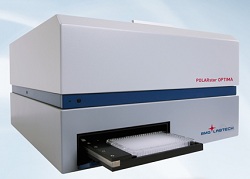IT MAY be a problem faced by few laboratories, but any that need to cope with microplate readings in situations other than one standard Earth gravity need look no further than BMG Labtech’s Polarstar microplate reader.

Polarstar – the microplate reader for zero gravity
Researchers at the University of Tuebingen, Germany, have used the device in parabolic flights while studying the physiological effects of gravity fluctuations on plants.
Light and gravity are known to be the two main stimuli helping plants determine up and down, and so which direction to grow. The elimination of light is easy enough, but short of a trip to the International Space Station the only way to eliminate gravity is through parabolic flight.
These flights, sometimes nicknamed the ‘vomit comet’, are best known for their role in astronaut training but also have many other applications in scientific research.
By measuring calcium and hydrogen peroxide in plant cells during consecutive parabolic flights, using the Polarstar reader, the Tuebingen team can demonstrate the effects of gravity on plants.
During a flight, different stages of gravitation are obtained ranging from hypergravity (about 1.8g) to microgravity (about 0.001g). A typical flight sequence consists of around 30 consecutive parabolas in each of which the period of microgravity is about 22 seconds.
A Youtube video from flight operator Novespace (four minutes, French language with English subtitles), is available at http://www.youtube.com/watch?v=Lhu198E8z2U
This research programme investigated the signalling pathway from stimulus (no gravity) to response (activation or deactivation of the expression of certain genes). The level of two important second messengers, Ca2+ and hydrogen peroxide, were monitored. Two transgenic cell lines derived from Arabidopsis thaliana expressing either Cameleon (a calcium sensor) or HyPer (an H2O2 sensor) were used as well as a wild type. The calcium and hydrogen peroxide measurements were performed on a fixed Polarstar Optima in kinetic mode during the whole time of the parabolic flight.
Results show that the calcium levels increased with microgravity and decreased afterwards, signifying an effect on calcium flux due to changes in gravity.
Polarstar is a multimode plate reader that can measure fluorescence, luminescence, absorbance, and fluorescence polarisation.
